Capture epic surfing waves from above by mastering drone positioning and camera settings. Time your shots perfectly, anticipating the peak action moments. Experiment with height and angles to showcase wave patterns and surfer techniques. Track surfers dynamically, maintaining consistent framing. Don't shy away from low-light conditions; they offer unique creative opportunities. Create dynamic compositions using leading lines and interesting backgrounds. Consider weather factors for safety and image quality. Highlight scale by positioning your drone near wave crests. Post-process to enhance colors and textures. With these techniques, you'll elevate your aerial surf photography to new heights. The ocean's power and beauty await your lens.
Drone Positioning for Wave Shots
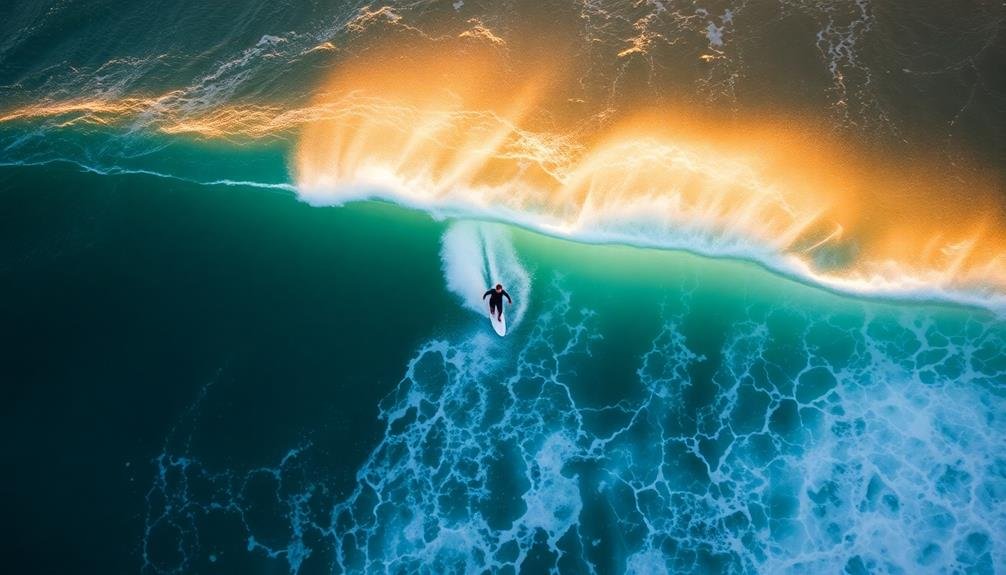
Numerous factors come into play when positioning your drone for stunning wave shots. First, consider the sun's position to capture the best lighting. Early morning or late afternoon often provides golden hour illumination, enhancing the water's texture and color. Aim to position your drone with the sun at your back for ideal clarity and contrast.
Wind direction is essential. You'll want to fly your drone against the wind for stability and to avoid drifting. This positioning also helps you maintain control when following surfers or tracking waves.
Height is another vital element. Experiment with different altitudes to find the sweet spot that showcases the wave's size and power while still capturing surfers in detail.
For dynamic shots, try flying parallel to the coastline as waves approach. This angle can create a sense of movement and scale. Alternatively, position your drone directly above breaking waves for a unique top-down perspective.
Don't forget to adjust your camera settings for the best results. Use a fast shutter speed to freeze action and a balanced aperture for overall sharpness.
Timing Perfect Surf Moments
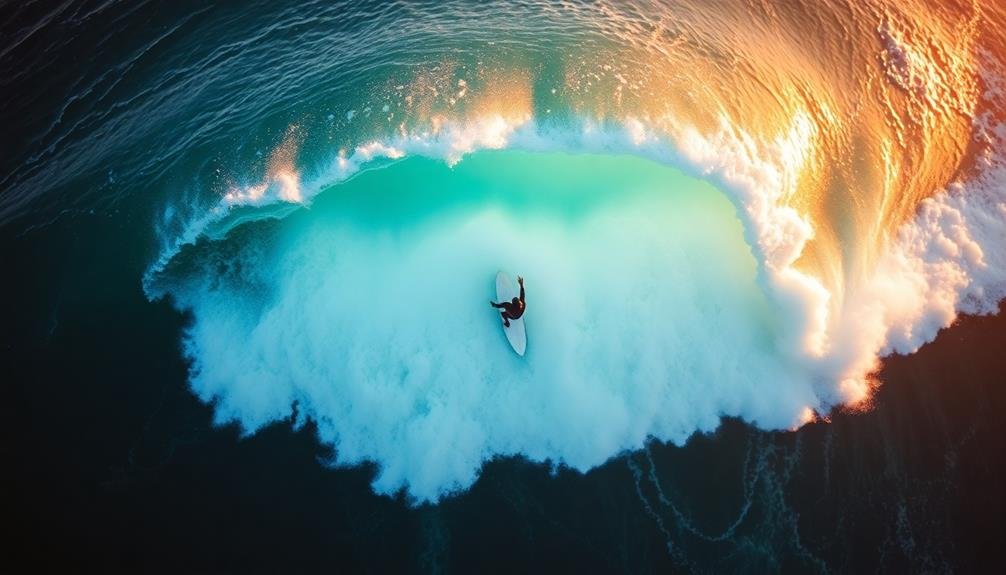
With your drone positioned perfectly, capturing the ideal surf moment becomes the next challenge. You'll need to anticipate the peak action and be ready to hit that shutter button at precisely the right instant.
Watch for the surfer's approach to the wave, and prepare as they begin to drop in. The most dramatic shots often come just as the surfer reaches the bottom of the wave and starts to carve up the face.
Keep an eye on wave patterns and sets. Larger waves typically come in groups, so be ready when you spot a promising set rolling in. If you're filming, start recording before the action begins to guarantee you don't miss anything. For still shots, use burst mode to capture a rapid sequence of images.
Pay attention to lighting conditions. Early morning or late afternoon light can create stunning contrasts on the water's surface. If you're shooting into the sun, expose for the highlights to create silhouettes.
Don't forget to take into account the background – a clean horizon or interesting coastline can elevate your shot from good to exceptional.
Capturing Wave Patterns From Above

Drones offer a unique perspective for capturing intricate wave patterns from high above the ocean's surface. You'll be amazed at the mesmerizing designs and textures that emerge when you view waves from this vantage point.
To capture stunning aerial shots of wave patterns, start by positioning your drone at least 100 feet above the water. This height allows you to see the broader patterns formed by multiple waves interacting.
Look for areas where waves converge or where currents create interesting swirls and eddies. Pay attention to how light interacts with the water's surface, creating highlights and shadows that enhance the patterns. Early morning or late afternoon light can produce dramatic contrasts, making wave patterns more visible.
Experiment with different camera angles and movements. Try slow, smooth pans to showcase the rhythmic nature of the waves. Alternatively, capture static shots to emphasize the intricate details of individual patterns.
Don't forget to adjust your camera settings for ideal results. Use a fast shutter speed to freeze the water's motion and a lower ISO to reduce noise in your images.
Tracking Surfers With Aerial Footage

Aerial footage has revolutionized the way we capture surfers in action. You can now track surfers from above, providing a unique perspective that showcases their skill and the wave's power simultaneously. To achieve this, you'll need a drone or helicopter equipped with a high-quality camera and stabilization system.
When tracking surfers, start by positioning your aerial device slightly ahead and to the side of the surfer. This angle allows you to capture both the surfer's movements and the approaching wave. As the surfer rides the wave, smoothly follow their trajectory, adjusting your altitude and speed to maintain a consistent frame.
Use a wide-angle lens to capture the entire scene, including the surfer, wave, and surrounding ocean. For close-ups, switch to a zoom lens, but be cautious not to lose sight of the overall action. Experiment with different heights and angles to create dynamic shots that highlight the surfer's technique and the wave's shape.
To add drama, try sweeping shots that start from behind the surfer and move alongside them as they ride the wave. This technique creates a sense of speed and immersion for viewers.
Low-Light Surf Photography Techniques
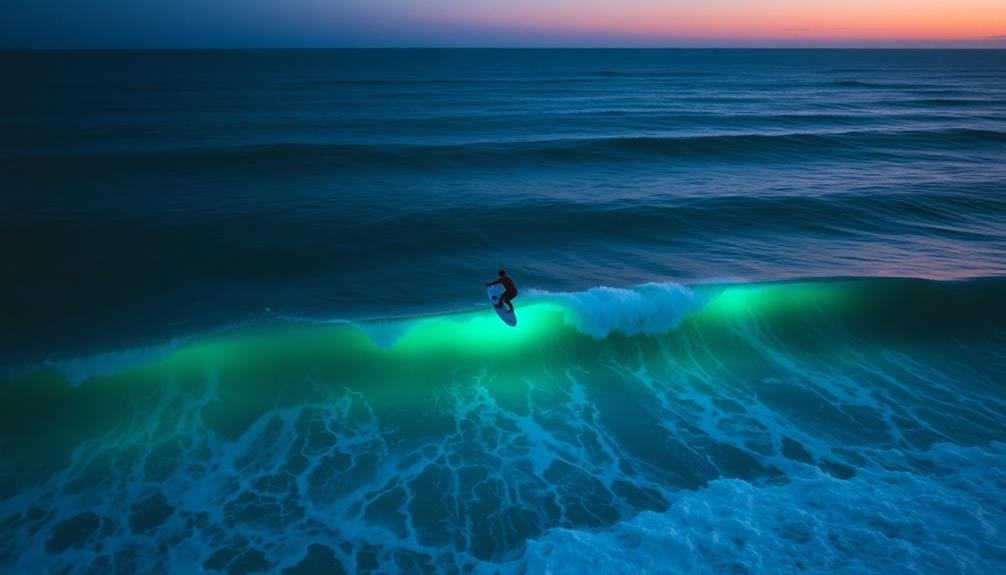
You'll find that low-light surf photography offers unique creative opportunities.
Night surf long exposures, moonlit wave illumination techniques, and pre-dawn silhouette shots can capture the ocean's beauty in dramatic new ways.
These methods require patience and specialized equipment, but they'll help you produce stunning images that stand out from typical daytime surf shots.
Night Surf Long Exposures
Moonlight dances on the waves as photographers venture into the domain of night surf long exposures. This technique allows you to capture the ethereal beauty of nighttime surfing, creating dreamlike images that blend motion and stillness.
To master night surf long exposures, you'll need a sturdy tripod, a remote shutter release, and a camera capable of manual settings. Set your ISO low (100-400) to minimize noise, and use a wide aperture (f/2.8-f/4) to gather as much light as possible. Experiment with shutter speeds between 10-30 seconds to achieve the desired effect.
Position yourself to capture both the surfer and the wave motion. Use the moon or artificial light sources to illuminate the scene. You can also try light painting techniques to add interest to your composition.
Focus manually on a static element in the frame, like rocks or a pier. Consider using neutral density filters to extend exposure times even further. Remember to shoot in RAW format for maximum flexibility in post-processing.
Be patient and take multiple shots, as night surf long exposures require practice to perfect. The results will be worth it, yielding unique and enthralling images of surfers riding moonlit waves.
Moonlit Wave Illumination Techniques
Nature's nocturnal light show presents unique challenges and opportunities for surf photographers. When capturing moonlit waves, you'll need to master long exposures and strategic lighting techniques.
Start by selecting a night with a full or nearly full moon, as it'll provide the most natural illumination. Position yourself to maximize the moon's reflection on the water's surface.
Use a sturdy tripod to keep your camera steady during extended exposures. Opt for a wide-angle lens with a large aperture to let in more light. Set your ISO between 800 and 3200, depending on the moon's brightness. Experiment with shutter speeds between 10 and 30 seconds to capture the wave's movement.
To enhance the moonlight, consider using artificial light sources. LED panels or powerful flashlights can help illuminate the waves' faces. Place these lights strategically to create depth and texture in your shots.
You can also try light painting techniques, using handheld lights to trace the wave's outline during the exposure.
Remember to protect your gear from sea spray and sand. Use weather-sealed equipment or protective covers to safeguard your camera and lens in the challenging beach environment.
Pre-Dawn Silhouette Shots
The pre-dawn hours offer a unique opportunity for capturing stunning silhouette shots of surfers. As the sky begins to lighten, you'll find a magical interplay of darkness and emerging light that's perfect for creating dramatic silhouettes.
Position yourself on an elevated vantage point, like a cliff or drone, to capture the surfers against the brightening horizon.
To achieve the best results, use a fast lens with a wide aperture to let in as much light as possible. Set your camera to manual mode, adjusting the ISO and shutter speed to maintain detail in the sky while rendering the surfers as dark shapes. Focus on the horizon to guarantee sharp outlines of the surfers.
For emotionally impactful silhouette shots, consider these elements:
- Striking poses: Capture surfers in dynamic positions, like mid-air jumps or barrel rides
- Reflections: Use calm water to create mirror-like images of surfers
- Colorful skies: Wait for vibrant pre-sunrise hues to add drama
- Multiple subjects: Frame several surfers to tell a more complex story
Remember to respect local regulations and surfers' privacy.
With practice, you'll master the art of pre-dawn silhouette photography, creating powerful images that evoke the thrill and serenity of early morning surfing.
Mastering Color in Ocean Aerials
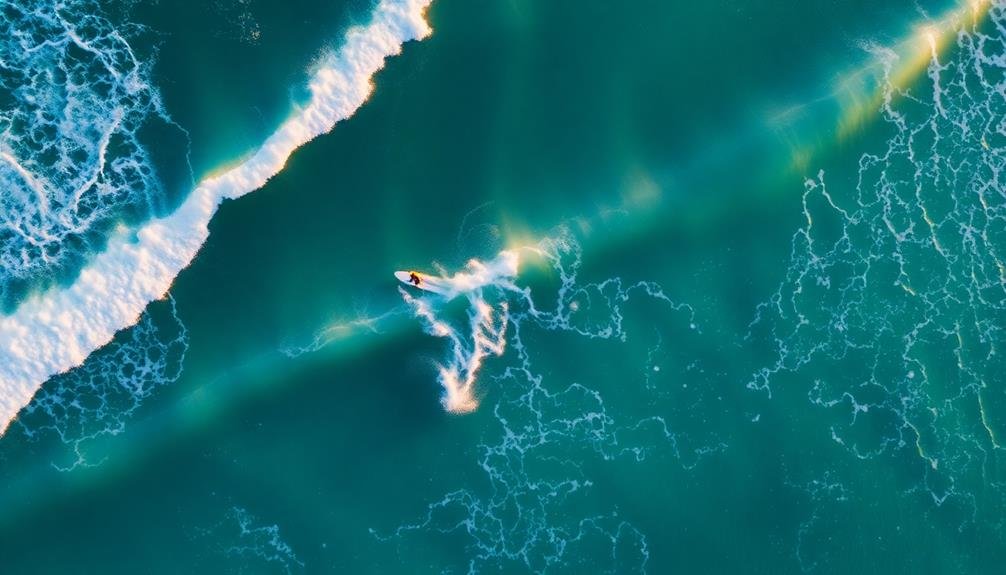
When capturing ocean aerials, mastering color is crucial for creating stunning images. You'll need to understand how light interacts with water at different times of day to achieve the best results. Early morning and late afternoon offer golden hues that can transform the ocean's surface into a mesmerizing palette.
To enhance color, adjust your camera's white balance settings to capture the ocean's true tones. Experiment with polarizing filters to reduce glare and boost saturation, revealing the water's vibrant blues and greens.
In post-processing, fine-tune contrast and vibrance to make colors pop without appearing unnatural.
Don't overlook the significance of composition in highlighting color. Frame your shots to include contrasting elements like white sand beaches or dark rocky outcrops. Look for patterns in the waves or reefs that create interesting color variations.
Be mindful of atmospheric conditions. Hazy days can mute colors, while clear skies intensify them.
You'll also want to reflect on the ocean's depth, as shallower areas often display more varied and vivid hues. By mastering these techniques, you'll capture ocean aerials that truly showcase the water's natural beauty.
Dynamic Compositions for Wave Shots
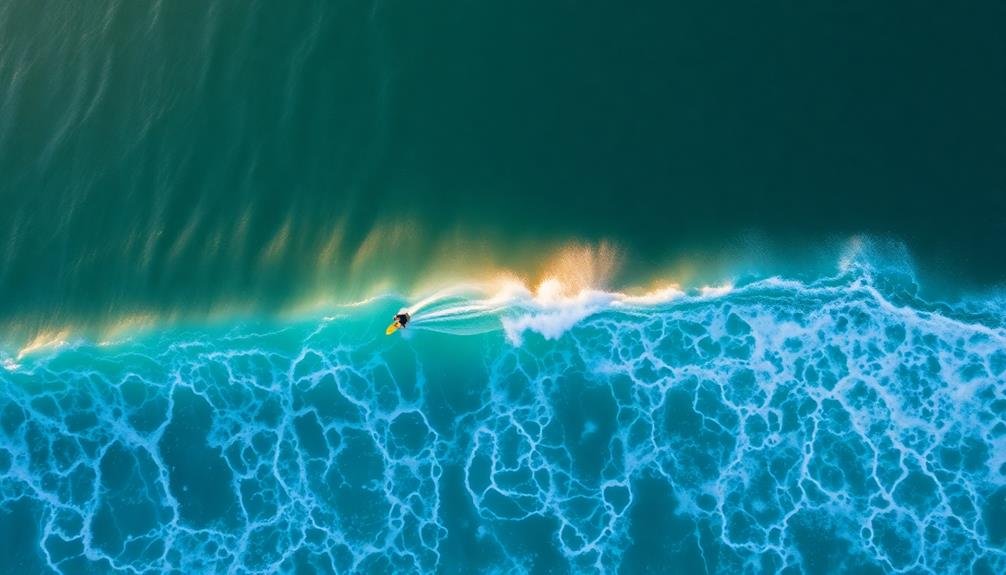
As you frame your aerial wave shots, consider the power of perspective to create depth and drama.
Experiment with tilting your camera or drone to capture unique angles that emphasize the wave's shape and movement.
Utilize leading lines, such as the curve of a breaking wave or patterns in the water, to guide the viewer's eye through your composition and create a dynamic, engaging image.
Aerial Perspective Techniques
Aerial photography's unique vantage point opens up a world of dynamic compositions for capturing waves. From above, you'll see patterns and textures that aren't visible from the ground.
To maximize your aerial wave shots, focus on timing and positioning. Wait for the perfect moment when the wave is at its peak, revealing its full shape and power.
Experiment with different altitudes to capture varying perspectives. Lower altitudes highlight details and textures, while higher altitudes showcase the broader seascape. Use leading lines, such as coastlines or breaking waves, to guide the viewer's eye through the image.
Don't forget to include surfers or boats for scale and added interest.
To evoke emotion in your audience, consider these aerial perspective techniques:
- Capture the raw power of massive waves crashing against rugged cliffs
- Highlight the serenity of pristine, untouched beaches stretching for miles
- Showcase the contrast between deep blue ocean and white foam patterns
- Frame the isolation of a lone surfer surrounded by vast, rolling waves
Leading Lines Strategy
Three key types of leading lines can dramatically enhance your aerial wave photography: natural coastlines, breaking waves, and man-made structures. When shooting from above, look for curves and straight lines that draw the viewer's eye through the image. Coastlines often provide natural leading lines, guiding attention to breaking waves or surfers. The waves themselves create dynamic lines, especially when they're curling or crashing against the shore.
Man-made structures like piers, jetties, or even roads near the coast can add interesting geometric elements to your compositions. Use these to frame your subject or create a sense of scale. Remember to experiment with different angles and heights to find the most compelling lines.
To maximize the impact of leading lines, consider these techniques:
| Technique | Effect | Example |
|---|---|---|
| Diagonal | Creates tension | Angled coastline |
| S-curve | Adds flow | Winding river mouth |
| Converging | Focuses attention | Pier pointing to surfer |
| Parallel | Emphasizes repetition | Multiple wave sets |
Weather Considerations for Drone Surfing
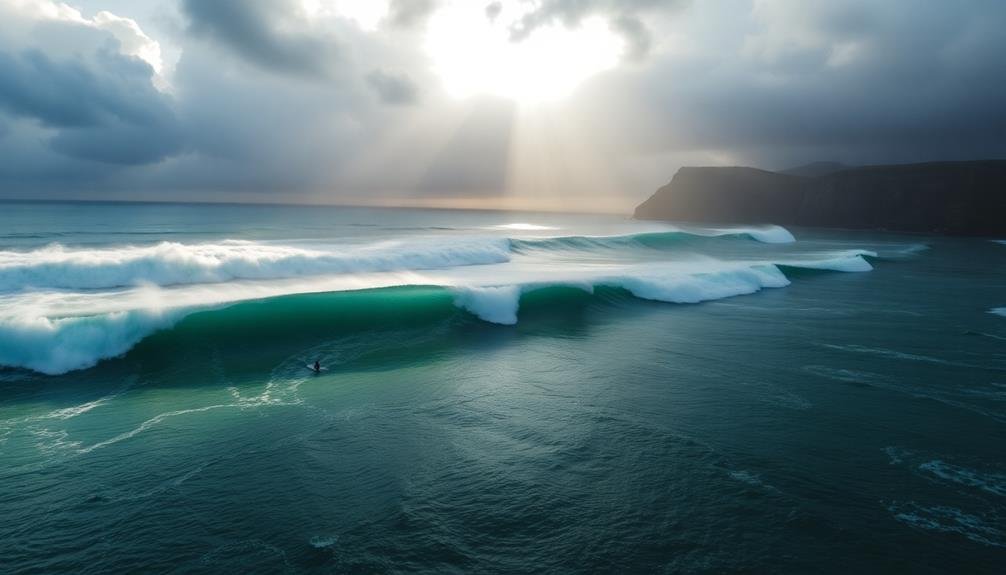
Weather plays an essential role in drone surfing, influencing both safety and performance. You'll need to take into account wind speed and direction, as strong gusts can destabilize your drone and affect image quality. Aim for calm days with winds under 10 mph for ideal control and stability.
Cloud cover and lighting conditions are vital factors. Overcast skies can provide soft, even lighting for your shots, while bright sunlight may create harsh shadows and glare on the water's surface. Early morning or late afternoon often offer the best lighting for dramatic surf photography.
Temperature and humidity can impact your drone's battery life and overall performance. In colder conditions, batteries drain faster, so pack extras and keep them warm. High humidity might cause lens fogging, so think about using anti-fog products.
When planning your drone surfing session, keep these emotional aspects in mind:
- The thrill of capturing perfect waves from a unique perspective
- The serenity of flying above the ocean's vastness
- The excitement of chasing surfers and documenting their skills
- The pride in creating stunning visuals that showcase nature's power
Always prioritize safety and follow local regulations when operating your drone near the coast.
Showcasing Scale in Aerial Waves
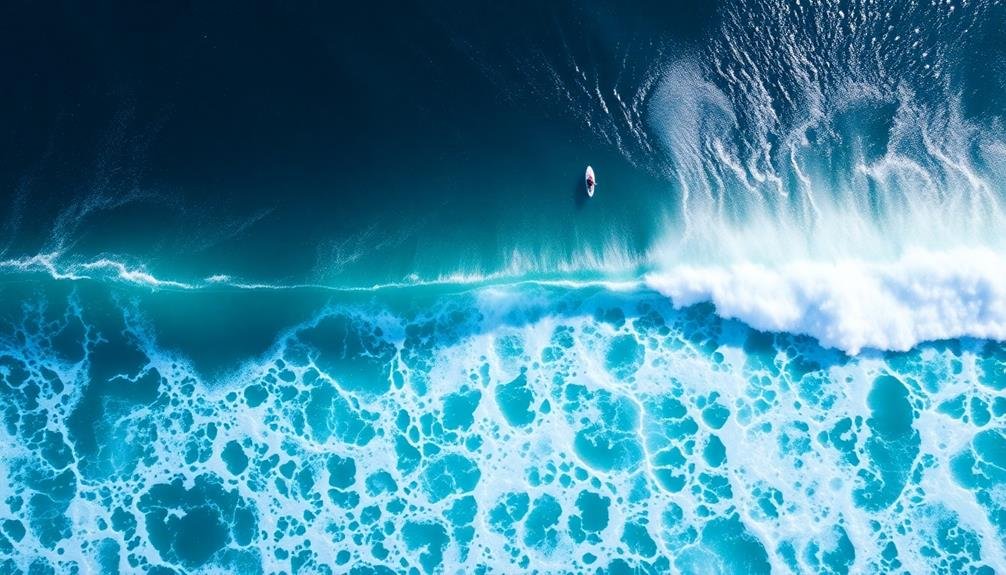
You'll find that drones can serve as excellent visual references when capturing the scale of waves from above.
By positioning a drone near the crest or face of a wave, you're able to provide viewers with a clear sense of the wave's true size.
This aerial perspective, combined with the known dimensions of the drone, allows for more accurate estimations of wave heights and offers a unique way to showcase the power and magnitude of the ocean.
Drones for Size Comparison
Utilizing drones for size comparison has revolutionized our perception of massive waves from above. By placing a drone near a surfer or object of known size, you can provide viewers with a clear reference point to grasp the true scale of the waves. This technique adds depth and context to your aerial shots, making them more impactful and memorable.
When incorporating drones for size comparison, consider these emotional elements:
- Awe: Capture the sheer magnitude of waves dwarfing surfers
- Excitement: Showcase the thrill of riding alongside enormous swells
- Respect: Highlight the power of nature and the ocean's force
- Inspiration: Motivate viewers to push their limits and embrace adventure
To effectively use drones for size comparison, position them strategically. Fly your drone at the same altitude as the surfer or reference object, maintaining a consistent distance. This approach guarantees accurate proportions and prevents distorted perspectives.
Experiment with different angles and distances to find the most compelling composition that emphasizes the wave's scale. Remember to follow local drone regulations and prioritize safety when operating near surfers and in coastal areas.
Aerial Wave Height Estimation
Accurately estimating wave height from aerial footage can be challenging, but it's essential for showcasing the true scale of massive swells. To capture the true magnitude of waves, you'll need to employ some clever techniques.
One effective method is to use known objects for scale. Include surfers, boats, or jetskis in your shots to provide viewers with a familiar reference point. This comparison helps convey the wave's size more accurately than standalone footage.
Another approach is to utilize your drone's altitude data. By maintaining a consistent height and angle while filming, you can create a reliable scale for estimating wave heights. You can then use this information to add on-screen graphics or captions that indicate the approximate size of the waves.
Consider incorporating aerial mapping techniques to create 3D models of the waves. This advanced method allows for precise measurements and can produce stunning visualizations of wave heights and patterns.
Lastly, don't forget to capture a variety of angles and perspectives. Combining wide shots with close-ups of the wave face will give viewers a thorough understanding of the wave's size and power.
Post-Processing Aerial Surf Images

Once you've captured stunning aerial surf images, it's time to plunge into post-processing. Your raw footage likely needs some adjustments to truly showcase the power and beauty of the waves.
Start by importing your images into your preferred editing software, whether it's Adobe Lightroom, Capture One, or DxO PhotoLab.
Begin with basic adjustments like exposure, contrast, and white balance. These foundational tweaks will set the stage for more advanced edits.
Next, focus on enhancing the colors of the water and sky. Boost the blues and teals to make the ocean pop, but be careful not to oversaturate.
To evoke emotion in your audience, consider these four key aspects:
- Highlight the texture of the water's surface
- Accentuate the curve and shape of the waves
- Emphasize the contrast between the white foam and deep blue water
- Showcase the scale of the surfers against the enormous waves
Don't forget to sharpen your images and reduce noise, especially if you've shot in low light conditions.
Frequently Asked Questions
What Are the Legal Restrictions for Flying Drones Over Beaches?
You'll need to check local regulations, as drone laws vary by location. Generally, you can't fly over people, must maintain visual line of sight, and may need permits for commercial use. Always respect privacy and safety guidelines.
How Do You Protect Your Drone From Saltwater Damage?
To protect your drone from saltwater damage, you'll want to rinse it with fresh water after each flight, apply a protective coating, and avoid flying in heavy sea spray. Don't forget to clean and dry your batteries too.
What's the Best Drone Model for Capturing Surf Photography?
For surf photography, you'll want to contemplate the DJI Mavic 3 Pro. It's got excellent image quality, long flight time, and weather resistance. You'll also appreciate its zoom capabilities and obstacle avoidance features for capturing those perfect waves.
How Can You Communicate With Surfers While Operating a Drone?
You can communicate with surfers while operating a drone by using hand signals, walkie-talkies, or pre-arranged visual cues. It's essential to establish a clear communication system before the session to guarantee safety and coordination during filming.
Are There Specific Insurance Considerations for Aerial Surf Photography?
Yes, you'll need specialized drone insurance for aerial surf photography. It should cover potential damage to your equipment, liability for injuries, and environmental risks. Check local regulations, as some areas require specific coverage for coastal operations.
In Summary
You've now got the tools to capture breathtaking aerial surf shots. Remember, it's all about timing, positioning, and creativity. Don't be afraid to experiment with different angles and techniques. Keep an eye on the weather and always prioritize safety. With practice, you'll master the art of showcasing the power and beauty of waves from above. So grab your drone, head to the beach, and start creating stunning surf photography that'll leave viewers in awe.

As educators and advocates for responsible drone use, we’re committed to sharing our knowledge and expertise with aspiring aerial photographers.
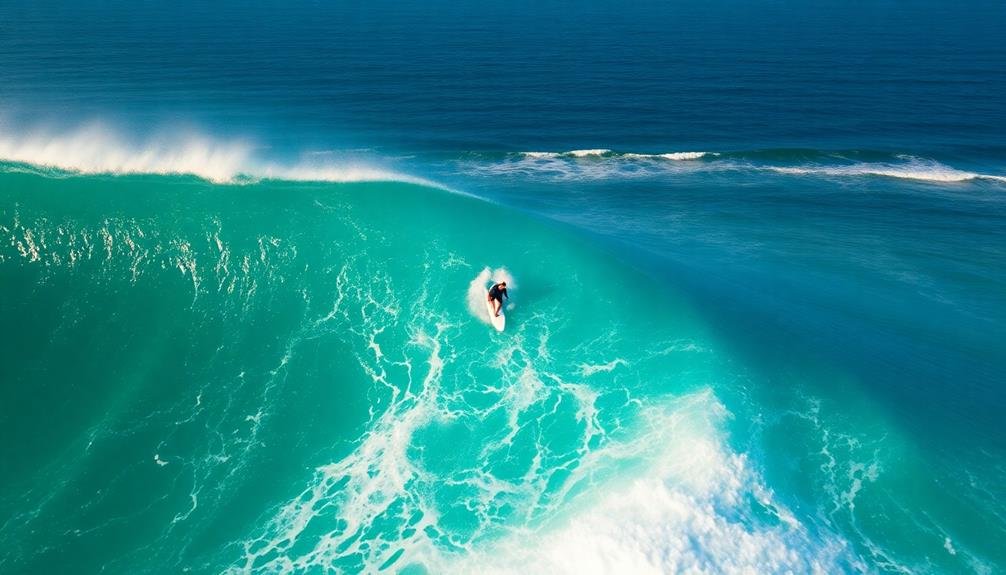



Leave a Reply